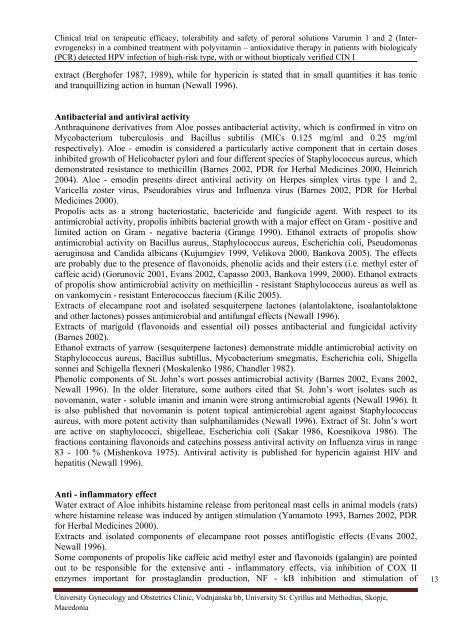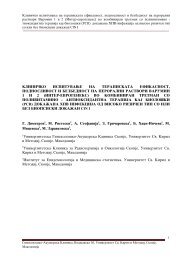klini^ko ispituvawe na terapiskata efikasnost, podnoslivost i
klini^ko ispituvawe na terapiskata efikasnost, podnoslivost i
klini^ko ispituvawe na terapiskata efikasnost, podnoslivost i
You also want an ePaper? Increase the reach of your titles
YUMPU automatically turns print PDFs into web optimized ePapers that Google loves.
Clinical trial on terapeutic efficacy, tolerability and safety of peroral solutions Varumin 1 and 2 (Interevrogeneks)<br />
in a combined treatment with polyvitamin – antioxidative therapy in patients with biologicaly<br />
(PCR) detected HPV infection of high-risk type, with or without biopticaly verified CIN I<br />
extract (Berghofer 1987, 1989), while for hypericin is stated that in small quantities it has tonic<br />
and tranquillizing action in human (Newall 1996).<br />
Antibacterial and antiviral activity<br />
Anthraquinone derivatives from Aloe posses antibacterial activity, which is confirmed in vitro on<br />
Mycobacterium tuberculosis and Bacillus subtilis (MICs 0.125 mg/ml and 0.25 mg/ml<br />
respectively). Aloe - emodin is considered a particularly active component that in certain doses<br />
inhibited growth of Helicobacter pylori and four different species of Staphylococcus aureus, which<br />
demonstrated resistance to methicillin (Barnes 2002, PDR for Herbal Medicines 2000, Heinrich<br />
2004). Aloe - emodin presents direct antiviral activity on Herpes simplex virus type 1 and 2,<br />
Varicella zoster virus, Pseudorabies virus and Influenza virus (Barnes 2002, PDR for Herbal<br />
Medicines 2000).<br />
Propolis acts as a strong bacteriostatic, bactericide and fungicide agent. With respect to its<br />
antimicrobial activity, propolis inhibits bacterial growth with a major effect on Gram - positive and<br />
limited action on Gram - negative bacteria (Grange 1990). Ethanol extracts of propolis show<br />
antimicrobial activity on Bacillus aureus, Staphylococcus aureus, Escherichia coli, Pseudomo<strong>na</strong>s<br />
aeruginosa and Candida albicans (Kujumgiev 1999, Velikova 2000, Bankova 2005). The effects<br />
are probably due to the presence of flavonoids, phenolic acids and their esters (i.e. methyl ester of<br />
caffeic acid) (Gorunovic 2001, Evans 2002, Capasso 2003, Bankova 1999, 2000). Ethanol extracts<br />
of propolis show antimicrobial activity on methicillin - resistant Staphylococcus aureus as well as<br />
on vankomycin - resistant Enterococcus faecium (Kilic 2005).<br />
Extracts of elecampane root and isolated sesquiterpene lactones (alantolaktone, isoalantolaktone<br />
and other lactones) posses antimicrobial and antifungal effects (Newall 1996).<br />
Extracts of marigold (flavonoids and essential oil) posses antibacterial and fungicidal activity<br />
(Barnes 2002).<br />
Ethanol extracts of yarrow (sesquiterpene lactones) demonstrate middle antimicrobial activity on<br />
Staphylococcus aureus, Bacillus subtillus, Mycobacterium smegmatis, Escherichia coli, Shigella<br />
sonnei and Schigella flexneri (Moskalenko 1986, Chandler 1982).<br />
Phenolic components of St. John’s wort posses antimicrobial activity (Barnes 2002, Evans 2002,<br />
Newall 1996). In the older literature, some authors cited that St. John’s wort isolates such as<br />
novomanin, water - soluble imanin and imanin were strong antimicrobial agents (Newall 1996). It<br />
is also published that novomanin is potent topical antimicrobial agent against Staphylococcus<br />
aureus, with more potent activity than sulphanilamides (Newall 1996). Extract of St. John’s wort<br />
are active on staphylococci, shigelleae, Escherichia coli (Sakar 1986, Koesnikova 1986). The<br />
fractions containing flavonoids and catechins possess antiviral activity on Influenza virus in range<br />
83 - 100 % (Mishenkova 1975). Antiviral activity is published for hypericin against HIV and<br />
hepatitis (Newall 1996).<br />
Anti - inflammatory effect<br />
Water extract of Aloe inhibits histamine release from peritoneal mast cells in animal models (rats)<br />
where histamine release was induced by antigen stimulation (Yamamoto 1993, Barnes 2002, PDR<br />
for Herbal Medicines 2000).<br />
Extracts and isolated components of elecampane root posses antiflogistic effects (Evans 2002,<br />
Newall 1996).<br />
Some components of propolis like caffeic acid methyl ester and flavonoids (galangin) are pointed<br />
out to be responsible for the extensive anti - inflammatory effects, via inhibition of COX II<br />
enzymes important for prostaglandin production, NF - kB inhibition and stimulation of<br />
University Gynecology and Obstetrics Clinic, Vodnjanska bb, University St. Cyrillus and Methodius, Skopje,<br />
Macedonia<br />
13



